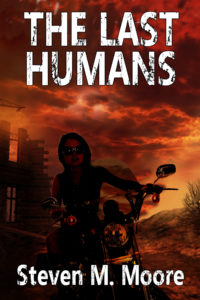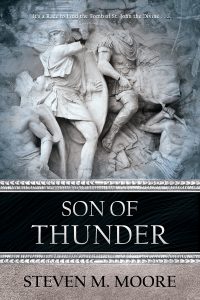Antiquity’s roadshow…
In spite of the obvious play on the title of the PBS series (I got the idea for the auction in Son of Thunder by watching it one night!), this post is about a particular fiction plot, the road trip. From Homer’s classic Odyssey to Kornbluth’s sci-fi novel Not This August and the movie Thelma and Louise, I’ve enjoyed these types of stories (I’ve only named a few, of course). So I’ve also written a few.

Muddlin’ Through, #1 in the “Mary Jo Melendez Mysteries,” is essentially a road trip; so is the first part of my recent post-apocalyptic thriller The Last Humans. But the one that is very different is St. John’s in Son of Thunder, #2 in the “Esther Brookstone Art Detective Series.” It’s a tale of three centuries, and I can call St. John’s story antiquity’s roadshow.
What St. John the Divine did as the longest living disciple between the Resurrection and his death is lost in antiquity. Some say he wrote the Book of Revelation (should that have quotes around it…or just around the word Revelation?). His authorship of the apocalyptic climax to the Bible isn’t clear, especially because it’s so different from his gospel. The Book of Revelation is a return to the fire and brimstone of the Old Testament’s vengeful God, not the loving and forgiving message of God the Christ from John’s gospel. But whatever occurred near the end of John’s life, all those middle years are lost.

So I put John, one of the disciples Christ called the sons of thunder (his brother James was the other one), on the road, a missionary and rebel (as far as the Roman Empire was concerned) who promoted Christianity and thwarted the will of the Empire. A holy road trip, and with his preaching, a roadshow for the people who needed to hear Christ’s message (it might be blasphemous, but Neil Diamond’s “Brother Love’s Traveling Salvation Show” could be playing in the background). I’d like to think that was what he was doing; I have no proof for it.
In Son of Thunder, John has a willing accomplice in Mary Magdalene. She’s an even more mysterious person lost in antiquity. (Her gospel only exists in a Coptic translation as far as I know.) Her real role during Christ’s time is a bit obscure—Dan Brown’s and Martin Scorsese’s wild (and maybe blasphemous?) conjectures aside, there’s some evidence that she was a rich benefactor for His movement—so I also made her into a missionary and rebel whose own roadshow in the novel often intersects with John’s. She’s also the right woman to provide contrast with the old boys’ club of early Church leaders (she was the first one at the tomb, after all) who cemented their male dominance by making her into a loose woman (I still hear homilies from the pulpits claiming that). That old boys’ club still exists, of course, but there are some holes now in the ancient dikes of tradition and intransigence.
Historical fiction’s goal is to fill in the gaps in the historical records and make an interesting story, guesses about what really happened. I tried to do that in Son of Thunder, partly the tale of John and Mary Magdalene’s road trips. Could something like this tale be true? I’d like to think so because it would add to the heroic nature of these two characters from the time of Christ.
I know some people will object and say that I take historical fiction too far because I make up a tale involving a saint. Hmm. How should I respond to that? Why are gaps in our knowledge about the saints taboo for historical fiction writers? Isn’t missionary work a noble calling for a saint? Couldn’t early saints become rebels in a movement to topple an autocratic empire, not fighting with weapons but with their words? Or writings, the pen being mightier than the sword? Or should I just state that those naysayers don’t have to read my novel and be done with it?
I hope this book doesn’t create such controversy, though. That was never really my intention when writing it. On the contrary, it was my way to become closer to St. John, that historic figure, and his complicated historical milieu. If further archaeological research proves me wrong, so be it. My story will still be valid historical fiction.
***

Comments are always welcome.
Son of Thunder. In this sequel to Rembrandt’s Angel, art detective Esther Brookstone is asked by her old MI6 handler to authenticate a Botticelli painting. She finds a parchment tucked into the frame, a word map to St. John the Divine’s tomb. The saint’s story, Botticelli’s journey to find the tomb, and Esther’s obsession with finding it too, are three parallel stories that come together to make this stand-alone novel a mystery/thriller where history plays such an important role. Readers can also peek into Esther’s MI6 past and follow the progression of her romance with Interpol agent Bastiann van Coevorden. Available in ebook and print format from Amazon and the publisher, Penmore Press, and in ebook format from Smashwords and its affiliated retailers (iBooks, B&N, Kobo, etc.).
Around the world and to the stars! In libris libertas!
